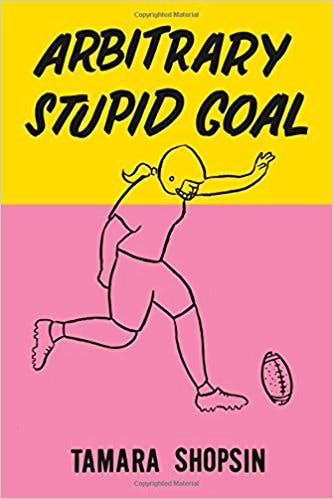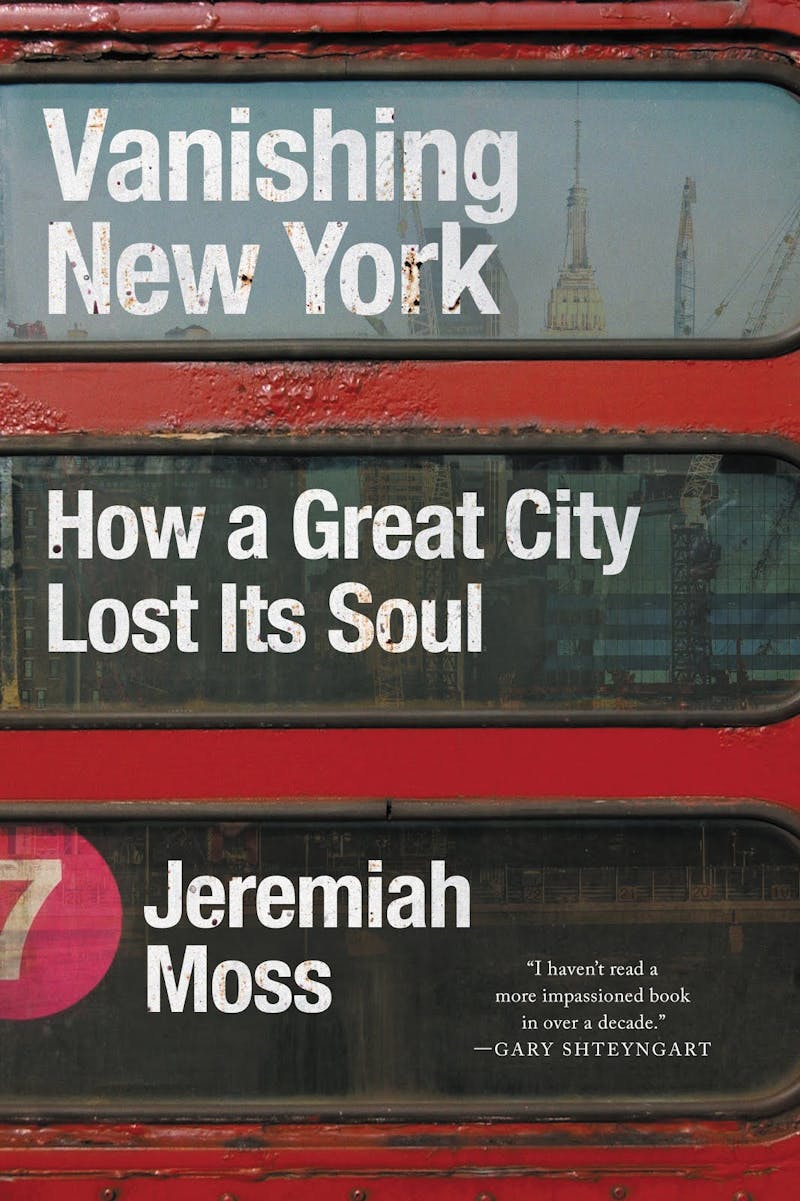It’s hard to think of a city more preoccupied with itself than New York. For the individual resident, there are all sorts of little personality quizzes a person can administer to qualify her place as a “real New Yorker”: The 10-years-of-residence rule is common, for instance (except to natives, to many of whom it’s trash). The writer E.B. White provided his own taxonomy in the 1949 essay “Here Is New York.” You’re born here, a commuter, or—“the greatest” of his three types—a transplant, “the person who was born somewhere else and came here in quest of something.”

Debut authors Jeremiah Moss (of the history Vanishing New York: How A Great City Lost Its Soul) and Tamara Shopsin (of the expert memoir Arbitrary Stupid Goal) both mention White’s classification system in recording their own versions of New York. Shopsin, born in what she calls “the matter-of-fact best place on earth,” considers White’s essay fact, but identifies an omission: The transplant New Yorker “knows they can live somewhere else. … The first New Yorker has no such reservoir.”

Shopsin’s personal bedrock is her 1970s and ’80s upbringing on Greenwich Village’s Morton Street, where she and a clutch of siblings helped run what they all call “The Store,” the first location of Shopsin’s, her family’s diner. The diner showcased her family’s particular habits: The menu had more than 900 items and a sign above the counter read ALL OUR COOKS WEAR CONDOMS. As far as Shopsin is concerned, it was a wonderful place to grow up. “None of us saw working at The Store as a chore,” she writes, and this is largely because of its regulars. New York is the container for the author’s familial and neighborly love—form-imposing like a pie tin. Her world recalls how Jack Kerouac described New York: “New York gets god-awful cold in the winter but there’s a feeling of wacky comradeship somewhere in some streets.” As Shopsin puts it: “‘The nutrients of New York City are in the fringe people.’ I was brought up to believe this.”
Shopsin’s New York is necessarily colloidal with others’, and the people who surround her come to represent the city itself. Willy, a local superintendent and central figure in Shopsin’s life and this book, has an elegantly crass way of talking and a charisma that organized their block; there’s the local who wore a daily uniform of “lots of denim and fur … part of his outfit was a shower cap”; there’s “Beatnik Bob from next door,” who is questioned by the paper on the arrest of a neighbor discovered to be a Russian spy. About whether this came as a surprise, Beatnik Bob says, “Everyone knew that. No one cared. … This is the Village. There’s commies, there’s queers, there’s blacks, we don’t judge.”
The last sentiment becomes less true as the 20th century comes to an end and the city changes hands. “The Village changed,” Shopsin writes. “Some people think it’s better. You can lick the corners and cabinets of it without a worry. But that hadn’t happened yet. The fringe people still had a home.” As gentrification creeps onto Morton Street, the newcomers begin to complain about the neighborhoods they interject. Shopsin describes this with brutal brevity: “A block that once held enough for anyone’s existence was no longer open to anyone,” she writes. “The Store was pushed out and I was evicted from the building I grew up in.” Shopsin acknowledges the haywire, dangerous elements of downtown New York in the late 20th century, but insists, for all its incommodious aspects, on “the spirit, life, and community that the chaos and inefficiency bred.”
Moss’s Vanishing New York is a history of how “wholesome” and corporate America caulked over the dark cracks and corners that once distinguished New York’s spirit, life, and community from the rest of the country’s. The book is an effortful reference for how New York morphed from a syncretic collection of diasporas—both extra-national and of the identity and mind—into a bland sovereignty of the mega-rich. Moss often tries to sound curmudgeonly, but is clearly heart-struck and psychically reliant upon New York’s wild singularity, which he believes is stocked by small businesses like Shopsin’s family’s. His love and devotion to New York and its people is clear both from the book and from his dutiful work on a blog of the same name, where since 2007 he has painstakingly archived a once-familiar New York as it’s flensed one small business at a time.
In the book, Moss cites the work of hundreds of writers, artists, historians, and other neighbors to demonstrate how 20th-century New York buckled under mercenary policies and institutions designed to benefit the rich. The 21st-century city became punitive, extraditing, and sometimes carceral toward the poor, nonwhite, and queer—and, now, to the middle class, like citizens with independent businesses of interest to real-estate vultures, or those living in subsidized residences, or in black areas. “Working-class and lower-income black, brown, and immigrant people [are] exiled to the suburbs as more affluent whites take the cities … the colorized suburb now receives the brutal treatment the inner city once did—neglect, predatory lending, and militarized policing that too often ends in the murder of black people.” New York’s role has flipped with suburbia’s: it is now closed to those without means.
Moss faults neoliberal avarice, which has been beckoned to New York’s neighborhoods by the siren call of (usually white) artists and the gentrification that follows them. But he emphasizes that the eradication of New York as it once was is the fault of the gormless politicians who failed to protect its less-wealthy residents, neighborhoods, and businesses—and in fact acted against their interests whenever that translated into more money. Neoliberalism thrives on uncertainty—and “New York’s fiscal crisis provided the perfect opportunity to introduce [a] free-market fundamentalist shock treatment.” Class alienation and division accelerated in the 1970s under Mayor Ed Koch, who manipulated redlining and other forms of discrimination embedded in the city’s sociopolitical structure to rearrange where people, and their money, lived in New York. Moss quotes him at a cocktail party, saying, “We’re not catering to the poor anymore. There are four other boroughs they can live in. They don’t have to live in Manhattan.”
The increasingly white and rich city was made exponentially more so by Rudy Giuliani, the rat king of broken-windows policing that criminalized so much street life; a mayor who once used riot police to evict homesteaders from the East Village buildings they legally occupied in order to demolish and sell the properties. The city became untethered from its people and their homes, free-falling skyward in the luxury developments coaxed up by the global-finance billionaire Mayor Mike Bloomberg from 2001 until 2014. Glassy new buildings grayed the city’s appearance, affordability, and feeling. (How Mayor Bloomberg’s takeover was abetted by the September 11 attacks is addressed in one of the book’s most wrenching chapters.) Moss’s factual, point-by-point analysis of New York’s perdition is based in context: Like the city, each event, person, and place exists in relation to what stands before, after, and beside it. The result is a remarkable atlas charting where New York has gone, and why.
It’s not the simple case anymore, as Charles Baudelaire wrote in “The Swan,” that “the form of a city changes faster, alas, than the human heart.” Instead, money is clogging New York’s arteries, stopping regular circulation. Go and count: Union Square, to pick one Manhattan example, has no independently owned businesses left, instead hosting Best Buy, Forever 21, Starbucks, Sephora, and similar megabrands. New York’s pulse is slackened by finance—but its people are still here, circulating through it together. Regardless of what’s been lost, all you have to do, in seeking the city’s vital signs, is choose to put your money and attention toward the health of the non-conglomerates that survive here.
Shopsin and Moss’s books are not only recollective, but generative. The authors of these books are shepherds of New York’s character and spiritual health. Moss is the founder of #SaveNYC, which has successfully protected New York mom-and-pops like Punjabi Deli, a 24-hour Lower East Side Desi cab stand, Ray’s Candy Store, and Second Avenue’s B&H Dairy, a kosher lunch counter with the best macaroni in cheese in town—except for that at Shopsin’s. Kenny, Tamara Shopsin’s father, still slings invectives and “slutty cakes”—peanut-butter pancakes—from a new location in the Essex Market. Together, these authors know that to preserve the more vivid and humane New York they describe, comradeship is everything. A New Yorker is someone who understands that a New York way of life is, at once, all ways of life. New York is a city of options. Shopsin and Moss suggest that a real New Yorker might attend to those that aren’t found elsewhere by frequenting her city’s small businesses and otherwise being a neighbor.
Whatever that grimy heartland might look like to a person privately, now it’s easy to long for New York even when you’re in it—a permanent kind of homesickness for the transplant and native resident alike, both of whom feel that something is not quite right in the city that, by birth or by choice, they call home. From Shopsin’s acknowledgements page: “It is the nature of New York to change … but not this lopsided toward the wealthy and Goliath.” Now, there’s an even simpler New York test than even E.B. White’s. The bottom of Moss’s longstanding website chronicling stomped-out New York landmarks, which generated his book, reads, “A NEW YORKER IS SOMEONE WHO LONGS FOR NEW YORK.” And does their best to preserve it.
